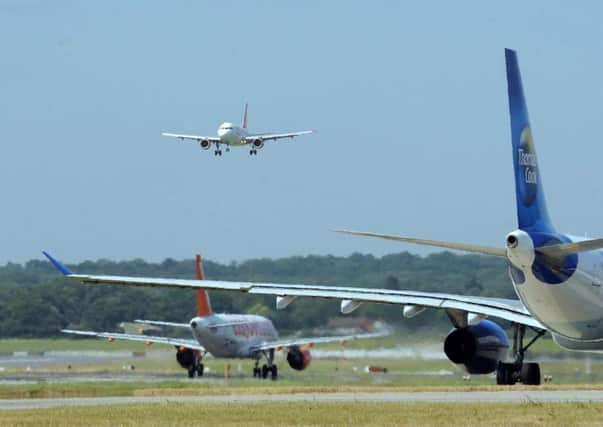Gatwick flightpaths: CAA conclusions announced


A statement from the CAA said: “European and national projects are improving airspace infrastructure to deliver a more efficient use of airspace and enable environmental improvements including fuel and CO2 savings by aircraft flying more direct routes.
“As part of this work Gatwick Airport sought the CAA’s approval to implement changes to their departure routes which we approved on 14 August 2013.
Advertisement
Hide AdAdvertisement
Hide Ad“These changes meant a move away from old ground-based navigation in order to utilise the improved navigational capabilities associated with satellite-based systems.
“Our approval was given after a consultation by the airport.
“Around one year after implementation of such an airspace change the CAA reviews whether the anticipated impacts and benefits have been delivered.
“In this case the review included a comprehensive study of flight paths flown and assessment of the significant amount of feedback we received from the general public, particularly over noise concerns.”
The review’s conclusion are:
Advertisement
Hide AdAdvertisement
Hide Ad- Six routes have delivered the aim of the change and will remain in their current state. These are routes 1, 3, 6, 7, 8 and 9.
- One route has not delivered the aim of the change and must be modified to an acceptable standard. This is route 4 which departs from the westerly runway and then turns right to head east to route north of the airport.
- Two routes have delivered the aim of the change to an acceptable standard but Gatwick has been required to consider whether modification could deliver a better outcome. These are routes 2 and 5. route 2 is from the easterly runway and turns right to route towards the south-coast and route 5 departs to the east from the easterly runway.
The routes referred to are:
Route 1: Westbound traffic towards Southampton from the westerly runway.
Advertisement
Hide AdAdvertisement
Hide AdRoute 2: Southbound traffic towards Seaford for routes across the English Channel from the easterly runway.
Route 3: Westbound traffic towards Southampton from the easterly runway.
Route 4: Eastbound traffic from the westerly runway which splits into four routes towards: Dover for eastbound traffic; Clacton for eastbound/northeast bound traffic; towards the Brentwood area for
northbound routes and towards Biggin Hill for positioning flights to Heathrow.
Advertisement
Hide AdAdvertisement
Hide AdRoute 5: Eastbound traffic from the easterly runway which then splits into three routes towards: Dover for eastbound traffic, Clacton for eastbound/northeast bound traffic, and towards Biggin Hill
for positioning flights to Heathrow.
Route 6: Eastbound traffic from the easterly runway which then turns north towards the Brentwood area for routes to the north.
Route 7: Southbound traffic towards Bognor Regis for routes across the English Channel (day time only) from the westerly runway.
Route 8: Southbound traffic towards Seaford for routes across the English Channel (night time only) from the westerly runway .
Advertisement
Hide AdAdvertisement
Hide AdRoute 9: Eastbound traffic towards Dover, northeast bound via Clacton or northbound via the Brentwood area from the westerly runway, but used as an overload route only.
“Gatwick Airport has been informed of our conclusions and is already working on the modifications we have required with a priority on route 4,” said the CAA statement.
“Both Gatwick and the CAA will work to implement any acceptable modifications taking into account internationally agreed schedules for publishing changes to airspace.
“UK airspace is a very limited and important part of our national transport infrastructure but the basic structure of the UK’s airspace was developed over forty years ago. Since then there have been
Advertisement
Hide AdAdvertisement
Hide Adhuge changes, including a hundred fold increase in demand for aviation.
“Throughout Europe there is a move to simplify and harmonise the way airspace and air traffic control is used through the Single European Sky project. In the UK and Ireland we’re meeting those
and other issues through the Future Airspace Strategy (FAS), which sets out a plan to modernise airspace by 2020.”
The full review is available on the CAA website here:
http://www.caa.co.uk/default.aspx?catid=2111&pagetype=90&pageid=16983.
Advertisement
Hide AdAdvertisement
Hide AdPhil Roberts, the CAA’s head of airspace, air traffic management and aerodromes said: “We absolutely understand that aircraft noise disturbs many people and we have taken the required amount of time to fully assess the considerable amount of feedback we have received from across the local communities.
“As we have done throughout this review, we will continue to consider the environmental impact of all our airspace decisions and have called on the aviation industry and other decision-makers to be much more ambitious in confronting aviation’s environmental challenges.”
-
Don’t miss out on all the latest breaking news where you live.
Here are four ways you can be sure you’ll be amongst the first to know what’s going on.
1) Make our website your homepage
2) Like our Facebook page
3) Follow us on Twitter
Advertisement
Hide AdAdvertisement
Hide Ad4) Register with us by clicking on ‘sign in’ (top right corner). You can then receive our daily newsletter AND add your point of view to stories that you read here.
And do share with your family and friends - so they don’t miss out!
Always the first with your local news.
Be part of it.